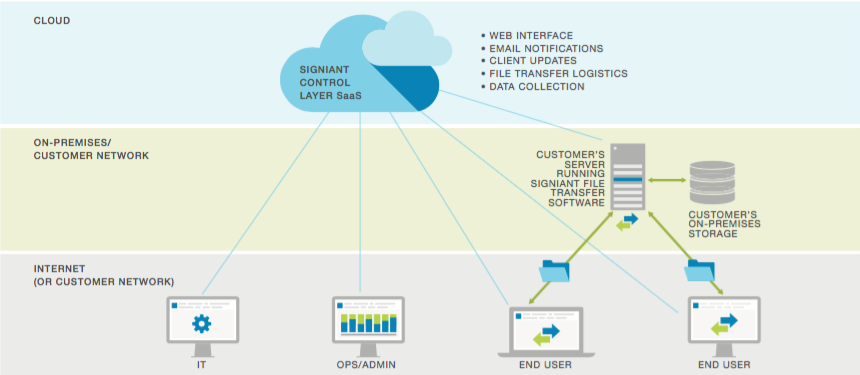How Media Shuttle Works: The Technical Perspective
How is Media Shuttle put together and what are the benefits from an IT perspective?
System Architecture
Media Shuttle incorporates the same acceleration, reliability and security technology as all Signiant products, delivered as a hybrid SaaS — meaning that part of the system is on-premises, and part is delivered by Signiant from the cloud. This contemporary new architecture extends and enhances the core transport functionality to create an easy to use, simple to deploy solution for people to send and share large (or any size) files.
A Media Shuttle deployment is shown in the diagram below:
At the core of the system are a server (running Signiant software) and storage on the customer’s network. This storage is the repository for data that users want to share, and/or the place where data is cached in a store-and-forward model for a person-to-person transfer. This is an important aspect of Signiant’s differentiated value — the data is in a storage location that is always under the customer’s direct control (which includes the option of storing files in the cloud). If you’re interested in learning about the cloud-backed version, read Media Shuttle with Cloud-Object Storage.
The SaaS part of the architecture, which is shown in blue in the diagram above, is where file transfer logistics are managed, user activity is tracked, and user web interfaces are hosted. It is a fully managed solution where Signiant administers all the backend technical tasks such as load balancing, web server management, and software upgrades. This SaaS component orchestrates the entire system via Internet connections and provides the web interfaces that enable people to interact with it, as indicated by the blue lines on the diagram.
To send or share files, end users interact with the system through simple branded portals that are accessed via a web browser. Each end user’s laptop or desktop computer must be equipped with client-side file transfer software to handle the data movement. This software, known as the Signiant App, is provided as a native Windows or Mac OS desktop application that requires a straightforward one-time installation on the user’s machine. Once the App software is in place, the user can simply access a Media Shuttle portal via a web page provided by the Signiant SaaS — and start sending and sharing files. As shown by the green lines on the diagram, data is moved between the client and server storage locations via the associated computers running Signiant file transfer software. The file transfer client is also available as an iOS app for mobile devices available from the Apple App Store.
Media Shuttle management interfaces (both IT and Ops/Admin) are provided as web pages, hosted by web servers provided and managed by Signiant as part of the Media Shuttle SaaS. These interfaces are accessed through standard web browsers (Chrome, Firefox, Safari, Edge, and Internet Explorer) and provide for the set-up, configuration and administration of portals. The management consoles are pure web interfaces requiring no plug-ins or native applications.
Taking a big-picture view of the system, the green and gray parts of the architecture diagram, where the data movement itself is happening, can be referred to as the ‘data plane’. The Signiant SaaS is the ‘control plane’, orchestrating the entire system. This separation of the data plane from the control plane is one of the key technical innovations of Media Shuttle, allowing customers to retain control of their content while simultaneously benefiting from the power of SaaS.
IT Considerations
Media Shuttle is a fully enterprise-ready solution that is used by some of the world’s largest corporations to handle their most valuable content. But the hybrid SaaS architecture and affordable price point also make it accessible to very small companies. In both scenarios, the concerns of the IT professionals responsible for overseeing the system were carefully considered and the system is optimized for their needs.
A key concept for all Signiant products is the principle of “storage independence”. Customers have the freedom and flexibility to select any storage type and location, on-premises or in the cloud, from the storage vendor(s) of their choice. One immediate IT benefit of this design is that Media Shuttle can be deployed without the need to modify, replace or add to the existing enterprise infrastructure. The only customer hardware requirement, beyond access to the storage and correct network and firewall configuration, is a server on which to install the transfer software. If more throughput or system redundancy is required, or if storage is geographically distributed, additional servers can be installed — and Signiant provides the additional server software free of charge.
Installation and set-up of the server software is done remotely by the Signiant deployment team, working with the customer’s IT staff During the initial set-up session, the Signiant team can also assist with configuration of the customer’s network router to support Port Forwarding, and configuration of the required ports for outbound and inbound traffic. Once the server and client software is installed, all that IT staff need to do is create and baseline configure the user-facing portals from within the IT web interface — a process that can be done in minutes. A typical Media Shuttle system is installed, fully deployed and in use by operational staff within days of signing a contract.
Portals can be one of three types:
- Send portals for person-to-person sending of files to one or more sender-selected, named individuals;
- Submit portals for multiple users submitting files to pre-defined folders;
- Share portals for multiple users uploading/downloading files to/from pre-defined storage folders configured for shared access.
Once the system is up and running, IT staff receive the full benefits of a multi-tenant SaaS solution: it is fully maintained and supported by Signiant, automatically upgraded with no downtime, and steadily delivers innovative new features. As a multi-tenant SaaS, Media Shuttle provides the scalability (more users and more transfers), elasticity (immediately auto-scale up and down as needed) and high availability (guaranteed performance at any scale) of a true cloud platform.
In addition to ease of deployment, support and maintenance, Media Shuttle offers a number of other benefits to customer IT staff:
➜ Control and Visibility:
Media Shuttle provides three different user interfaces for three different classes of users:
- IT interface for IT users;
- Administration (or Ops/Admin) interface for Operations Managers;
- User interface for end-users that instantiates one of the three classes of portal supported (Send, Submit and Share).
The IT interface allows the technical administrator to create new user-facing portals, define, configure and manage all aspects of the storage and network infrastructure, set limits on file sizes and the lifespan of user portals, and apply whatever other constraints and controls are needed. More advanced settings allow for sophisticated control over areas such as traffic routing, server load balancing, and permissions for working with non-members of a portal. The Administration (Ops/Admin) interface is a dashboard that gives full visibility over the usage of the portal (members, number of files transferred over time, largest files transferred, etc.). Additional capabilities allow for viewing and exporting (as .csv files) all portal events and transactions, including the full history of which files were transferred, when and by whom.
➜ Delegated Administration:
Delegated administration is a concept that benefits IT staff and operations managers equally. From within the IT interface, IT staff can delegate full administration rights over a portal to another user — typically an operations manager or project manager. Via the separate streamlined Ops/Admin interface, this designated manager can then add and remove users, monitor content flow, and change the portal design. This model ensures that IT retains control of key network and storage parameters, but absolves them of the need to spend time reconfiguring portals based on what are essentially non-technical, operational decisions. IT is freed up to focus on core technical tasks, while operational staff can make real-time operating decisions without needing to wait for IT to execute on their requests.
➜ Centralized Solution:
Another major IT benefit of Media Shuttle is that it enables organizations to consolidate all their file transfers within a singe solution; all transfer activity and users can be monitored, managed and controlled from a single place. Centralizing on Media Shuttle radically reduces technological sprawl within the enterprise, and eliminates all the associated support and control issues that result from alternative file transfer solutions such as FTP or OFS/EFSS.
➜ FTP Augmentation:
Many organizations rely heavily on FTP, and have dedicated resources to implementing FTP servers for sharing content. Media Shuttle can be installed alongside an existing FTP system and can share the same folders and file systems. By adding these storage locations during installation, users can gain the power and simple interfaces of Media Shuttle, and managers can gain enhanced visibility and insight into their data transfer activity, all without the need to migrate content or change existing content work flows.




